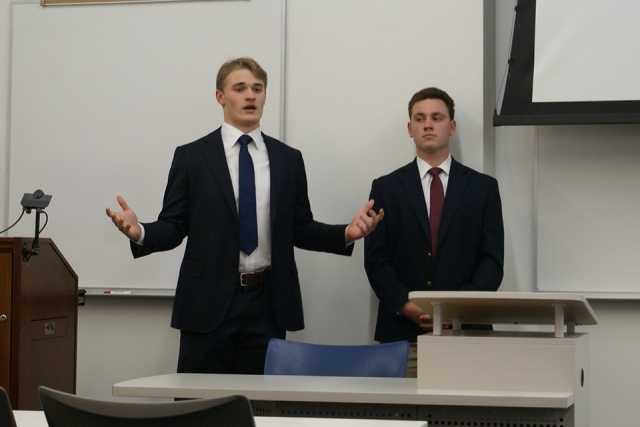
Students in The Peter J. Tobin College of Business at St. John’s University put their knowledge to the test on Friday, December 8, delivering their recommendations for a trio of student-managed endowment funds.
Teams of students presented a semester’s worth of research to faculty, administrators, and alumni at the University’s Manhattan, NY, campus. First to present were members of the Student-Managed Blockchain Fund (SMBF), followed by members of the undergraduate Student-Managed Investment Fund (SMIF) and members of the graduate-level SMIF.
For both the SMIFs and SMBF, students pitched increasing, reducing, or liquidating existing holdings and purchasing new holdings. All presentations included comprehensive student-created equity reports on the stocks or currencies.
“You really learn how to value a company when you do this amount of research,” said senior Joseph Guterding of Baldwin, NY, who partnered with junior Caiden Vlasimsky in a pitch to invest in a telecommunications infrastructure provider. “At the end of the day, when buying a stock, price matters. You want the stock to grow, but it is only a value to the SMIF if purchased at a good price.”
The undergraduate SMIF was established in 2001 and is now valued at $5.5 million. The graduate SMIF, started a year later, is valued at $3.6 million. The student Blockchain fund, launched in May 2022 with a $100,000 investment, is now worth about $177,000. Even in volatile times, both SMIFs have generated about eight to nine percent annualized returns since inception. The funds are part of the University’s endowment.
The evening of presentations was the climax for students enrolled in the fall-semester undergraduate courses Crypto Assets and Trading Strategies, and Managing Investment Funds, which are part of the Bachelor of Science in Finance degree program, as well as the graduate course Quantitative Asset Management, which is part of the Master of Science in Finance and Master of Business Administration programs.
“During the semester, students learned to appreciate and understand how the arrival of new information impacts asset prices and how analyzing the news can help inform investment decisions,” explained Mikael C. Bergbrant, Ph.D., Associate Professor, Department of Economics and Finance at Tobin. “The engagement during these courses is unlike others, as every class discussion lays the foundation for their trades and has real financial implications.”
Combining economic analysis with an awareness of global events, students identified some investment sectors that might be vulnerable in the coming year. Among those were financial services firms and luxury goods producers.
“Financial services firms do business all around the world and can be subject to geopolitical events,” observed Isabella Basso, from Garden City, NY, who teamed with fellow seniors Sabrina Chirafisi and Adrian Jubran in an analysis of the sector. “And that can impact consumer and commercial banking.”
The student-managed stock and blockchain funds are among several experiential-learning opportunities available to St. John’s students. The Tobin-based Executive-in-Residence Program enables students to engage in business consulting with actual corporate and nonprofit organizations. Other initiatives include the Design Factory product inspiration center at The Lesley H. and William L. Collins College of Professional Studies and the Global Loan Opportunities for Budding Entrepreneurs (GLOBE) student-managed lending program that assists business visionaries in the developing world. The University also sponsors other business-development initiatives, including the annual James and Eileen Christmas Business Plan Competition and Pitch Event.
Following the SMIF presentations, students voted on whether to recommend transactions to the University’s Funds Investment Committee. Later, all presenters joined attendees at a reception, where talk of the economy dominated.
Graduate students Anthony Evangelou and Kayser Zayer anticipated a downturn in the high-end retail sector amid growing talk of a potential recession. “When recessions happen, people cut back on luxury purchases and daily spending habits,” Anthony explained. “Some companies might not be suited for a recession.”
In their research, Joseph and Caiden searched for companies they believe are undervalued yet possess stable finances and the possibility for continued growth in their sectors. They settled on the telecommunications industry, anticipating greater future reliance on cloud and 5G technologies.
“You learn to think strategically, but also logically,” Caiden, from Dallas, TX, explained. “How much will people use the infrastructure that is being created, and how will it relate to changes happening in our society? We think we are entering a stage where people will need even more 5G, wireless, and cloud computing technology.”
On the cutting edge of financial technology is cryptocurrency, a form of digital money based on blockchain technology. Blockchain’s digital ledgers record transactions in code, holding the information together via cryptography. St. John’s students have navigated a volatile year, including fallout from the November 2022 collapse of leading cryptocurrency FTX. Also, many investors remain wary about the impact of interest-rate increases from the Federal Reserve on the cryptocurrency market.
Nevertheless, continued education in cryptocurrency investment remains essential, according to Zenu Sharma, Ph.D., Assistant Professor of Finance, adviser to the blockchain fund, and Crypto Assets and Trading Strategies instructor.
“Crypto is one of the most important new technologies,” Dr. Sharma said. “There is a lot of interest from the students in learning about this, and they generally feel they should know about it.”
